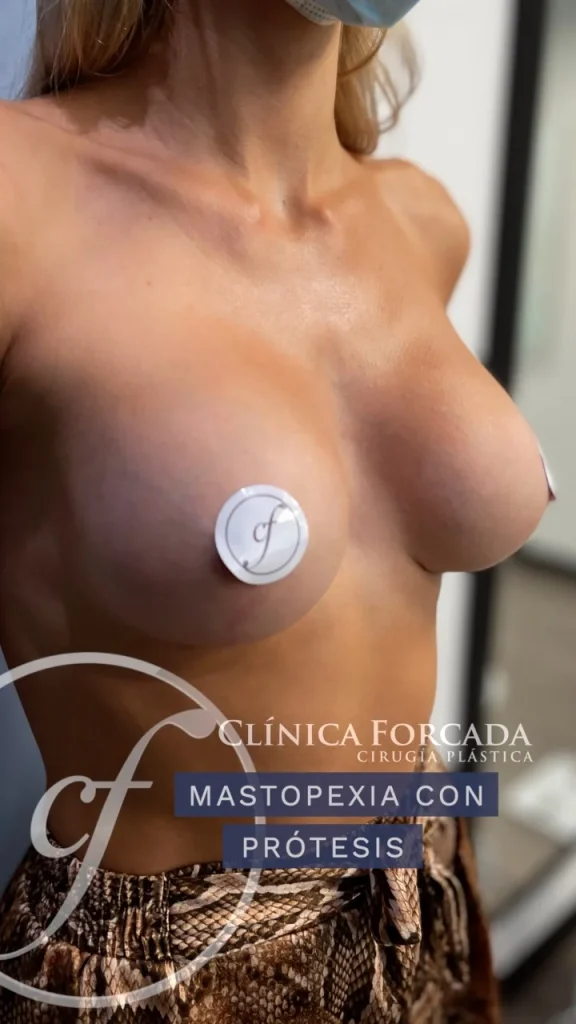Over the years, weight changes and pregnancies, the breast loses size and falls. That is the reason why almost every time we elevate the breast (mastopexy), we also need to fill it with an implant. Furthermore, mastopexy alone, without a prosthesis, tends to leave the breast one size smaller.
SURGERY SHEET
| DURATION OF SURGERY | Between 2 hours and 2 and a half hours, depending on the degree of fall. |
| IMPLANT POSITION | Subpectoral (below the muscle) |
| IMPLANT TYPE | Round |
| DRAINS? | No |
| SCAR | In inverted t, inverted minit, vertical or periareolar (depends on the degree of fall) |
| ENTRY NIGHT | YEAH |
ELEVATION OF THE AREOLA AND NIPPLE
During surgery, the nipple and areola are elevated to their ideal position, which is 1 to 2 cm above the inframammary fold. Therefore, in all mastopexies there will be a scar around the areola. Furthermore, in the vast majority of cases a scar will be necessary from the areola to the sulcus (vertical) and some horizontal scar at the level of the sulcus.
VERTICAL SCAR
The vertical scar allows us to eliminate excess skin in the lower part of the chest and therefore is what allows us to truly lift the chest. In most cases the scar is slightly visible as a pinkish mark one year after surgery, and almost invisible (as a white stretch mark) two years later. In some exceptional cases it may become somewhat pigmented (darker than the rest of the skin), in these cases an aesthetic touch-up is performed every year.
HORIZONTAL SCAR
The horizontal scar allows excess lateral skin to be removed. It is hidden at the level of the furrow. The neckline area can occasionally cause hypertrophic scarring. In these cases, massages, infiltration with corticosteroids or even cosmetic retouching are usually necessary. In general, it is an almost invisible scar between one and two years after surgery due to its hidden position in the undermammary fold.
ENTRY NIGHT
All inverted t, minit or vertical mastopexies spend the night in the hospital (only periareolar ones are discharged, if they want, on the first postoperative day). This measure allows for the best therapeutic management with intravenous treatment and allows us optimal control of the immediate postoperative period.
ROUND PROSTHESES
The sagging breast, whether due to weight changes or pregnancy, is a breast with lax skin and whose skin has a great tendency to stretch, therefore the prostheses we use are round prostheses, which have no risk of rotation and which The few months after the operation take on a completely natural form. Anatomical prostheses in these cases have a high risk of rotation and tend to leave empty breasts on top.
SUBPECTORAL
We place all implants below the muscle to minimize rippling (the visibility of the implant waves) and reduce the risk of capsular contracture. Furthermore, it has been shown that prostheses tend to fall less under the muscle than above them.
FREQUENT RISKS
- Capsular contracture : The main risk is capsular contracture. Mastopexies with prostheses are surgeries with a somewhat higher risk of capsular contracture than breast augmentations due to the longer duration of the surgery and the presence of bacteria (S.epidermidis) in the milk ducts of the mammary gland.
- Scars : Sometimes, the scars are darker than normal and require cosmetic retouching one year after surgery.
- Sagging of the gland, excess skin : Skin that has lost elasticity is skin that is easy to stretch and difficult to retract. In the immediate postoperative period the chest swells and then deflates. Sometimes, the skin stretches with inflammation and then does not recover 100% of its initial situation. In these cases, the aesthetic retouch is simple and consists of removing skin, mainly at the level of the vertical scar.
